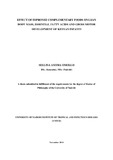| dc.description.abstract | Background: Kenya, like many other resource poor countries suffers from high prevalence of undernutrition as depicted by high stunting (35%), wasting (7%) and underweight (16%) among children under 5 years of age. Malnutrition is associated with retarded growth, psychomotor development and limited work capacity and achievement in later life. Undernutrition in early infancy may be addressed via sound nutrition practices including optimum breastfeeding and complementary foods. Specifically, complementary foods with animal source foodstuffs and vitamin and mineral fortificants may positively influence growth and development among infants.
Objective: To assess the efficacy on lean mass accrual, essential fatty acids profile and gross motor development among Kenyan infants receiving a daily portion of either two versions of locally produced complementary foods based on maize and germinated amaranth grains with (Winfood Classic [WC]) or without (Winfood Lite [WL]) animal source foods namely edible termites and small fish compared to a standard food aid product Corn-Soy-Blend plus [CSB+]).
Study design and participants: This was a randomised double-blinded trial in which a total of 499 infants were individually randomized to receive one of three food products (WFC, WFL and CSB+) for nine months from 6-15 months of age. Setting: A rural resource poor setting in Mumias District in Kenya characterized by high dependency on sugarcane production for cash with minimal food crop production. Methodology: Primary outcome was increment in fat-free body mass (FFM). Secondary outcomes were whole blood Essential Fatty Acids (EFA) status and attainment of gross motor milestones. FFM was measured by deuterium-dose- to-the-infant technique in which each infant received 3g deuterium oxide upon collection of 2ml pre-dose saliva sample. Two further postdose saliva samples were collected at 2-hour and 3-hours. Deuterium oxide enrichment in saliva was determined by Fourier Transform Infrared Spectrophotometry and fat free mass derived from total body water. Whole blood EFA was measured by fast gas chromatography. Gross motor milestones were determined based on windows of achievement by World Health Organization (WHO) Multicentre Growth Reference Study (MGRS) standards.
Results: There were no significant differences in FFM increment in WFC and WFL compared to CSB+ (WFC +0.14 (95% CI -0.19 to 0.46) and WFL +0.19 (95% CI -0.13 to 0.51). No significant differences were observed among the three foods in essential fatty acid profile. However, the infants receiving WFC had significantly greater concentration of arachidonic acid than infants receiving CSB+ group (p=0.004). There were no significiant differences among the three groups in gross motor milestone attainment. Secondary analysis showed that WFC group attained standing without assistance (p= 0.02) and walking without assistance (p= 0.004) earlier than the WFL group.
Conclusions: No significant differences in impact on lean mass accrual, essential fatty aacids profile and gross motor miletone attainment were observed from feeding locally produced complementary foods with or without animal source foods (termites and small fish) compared to a standard plant-based product. Since the WFC and WFL have similar health outcomes to CSB+, they may be utilized as improved complementary foods in populations where they are culturally aceptable | en_US |

